Green Marketing: Sustainable Practices and Coca-Cola Analysis
VerifiedAdded on 2021/05/30
|7
|1283
|177
Report
AI Summary
This report delves into the realm of green marketing, defining it as the practice of selling products and services based on their environmental benefits. It emphasizes eco-friendly production methods, including the use of non-toxic materials, sustainable manufacturing, and renewable resources. The report highlights the crucial link between green marketing and sustainable development, showcasing how companies integrate corporate social responsibility into their practices to attract environmentally conscious consumers and reduce operational costs. Using Coca-Cola as a case study, the report analyzes the company's green marketing initiatives across various components, including ingredients, packaging, manufacturing, distribution, refrigeration, and recycling. Coca-Cola's efforts involve using indigenous raw materials, redesigning packaging to reduce waste, optimizing distribution routes, and implementing sustainable refrigeration systems. The report references academic sources to support its findings, offering a comprehensive overview of green marketing strategies and their practical application in a major corporation.
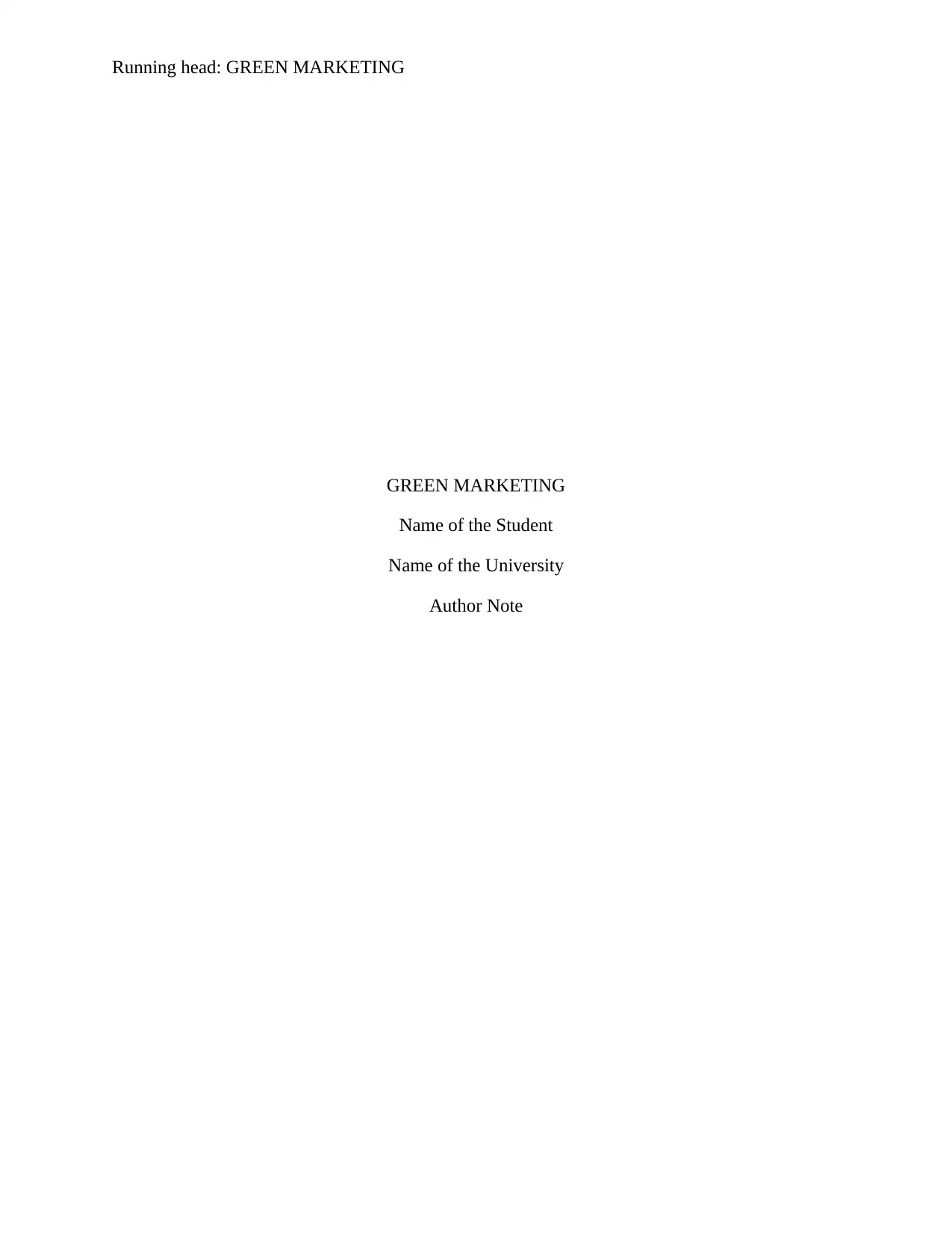
Running head: GREEN MARKETING
GREEN MARKETING
Name of the Student
Name of the University
Author Note
GREEN MARKETING
Name of the Student
Name of the University
Author Note
Paraphrase This Document
Need a fresh take? Get an instant paraphrase of this document with our AI Paraphraser
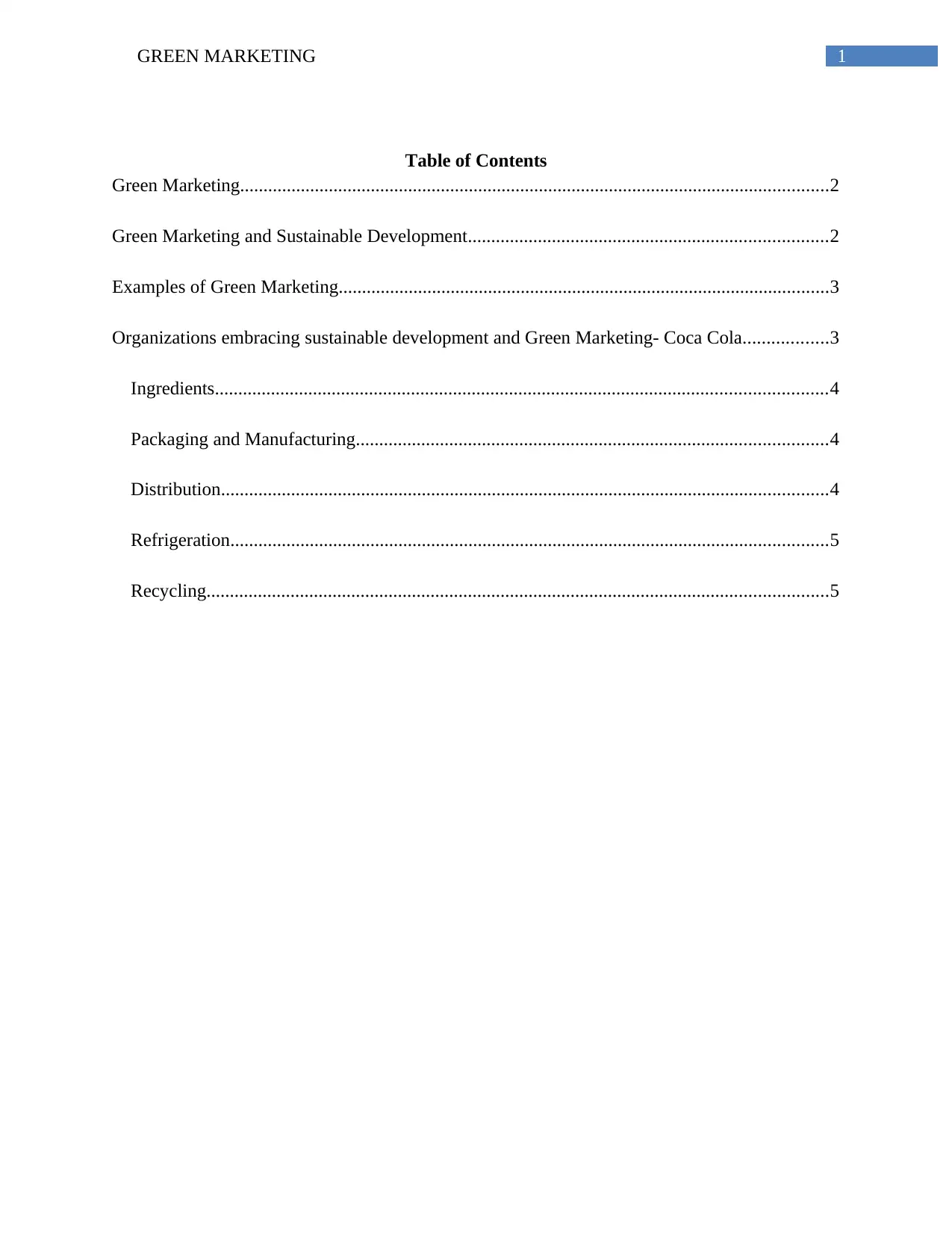
1GREEN MARKETING
Table of Contents
Green Marketing..............................................................................................................................2
Green Marketing and Sustainable Development.............................................................................2
Examples of Green Marketing.........................................................................................................3
Organizations embracing sustainable development and Green Marketing- Coca Cola..................3
Ingredients...................................................................................................................................4
Packaging and Manufacturing.....................................................................................................4
Distribution..................................................................................................................................4
Refrigeration................................................................................................................................5
Recycling.....................................................................................................................................5
Table of Contents
Green Marketing..............................................................................................................................2
Green Marketing and Sustainable Development.............................................................................2
Examples of Green Marketing.........................................................................................................3
Organizations embracing sustainable development and Green Marketing- Coca Cola..................3
Ingredients...................................................................................................................................4
Packaging and Manufacturing.....................................................................................................4
Distribution..................................................................................................................................4
Refrigeration................................................................................................................................5
Recycling.....................................................................................................................................5
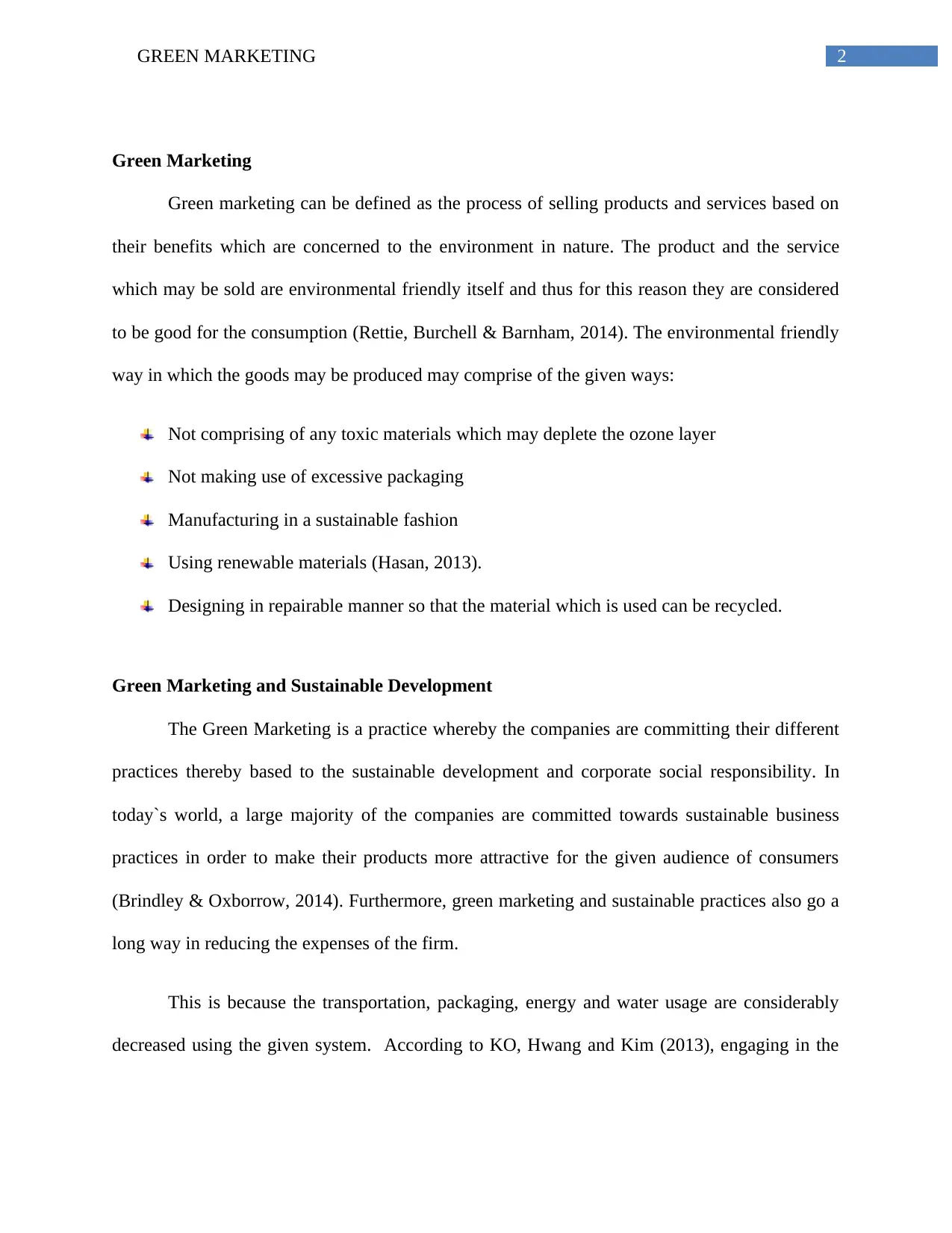
2GREEN MARKETING
Green Marketing
Green marketing can be defined as the process of selling products and services based on
their benefits which are concerned to the environment in nature. The product and the service
which may be sold are environmental friendly itself and thus for this reason they are considered
to be good for the consumption (Rettie, Burchell & Barnham, 2014). The environmental friendly
way in which the goods may be produced may comprise of the given ways:
Not comprising of any toxic materials which may deplete the ozone layer
Not making use of excessive packaging
Manufacturing in a sustainable fashion
Using renewable materials (Hasan, 2013).
Designing in repairable manner so that the material which is used can be recycled.
Green Marketing and Sustainable Development
The Green Marketing is a practice whereby the companies are committing their different
practices thereby based to the sustainable development and corporate social responsibility. In
today`s world, a large majority of the companies are committed towards sustainable business
practices in order to make their products more attractive for the given audience of consumers
(Brindley & Oxborrow, 2014). Furthermore, green marketing and sustainable practices also go a
long way in reducing the expenses of the firm.
This is because the transportation, packaging, energy and water usage are considerably
decreased using the given system. According to KO, Hwang and Kim (2013), engaging in the
Green Marketing
Green marketing can be defined as the process of selling products and services based on
their benefits which are concerned to the environment in nature. The product and the service
which may be sold are environmental friendly itself and thus for this reason they are considered
to be good for the consumption (Rettie, Burchell & Barnham, 2014). The environmental friendly
way in which the goods may be produced may comprise of the given ways:
Not comprising of any toxic materials which may deplete the ozone layer
Not making use of excessive packaging
Manufacturing in a sustainable fashion
Using renewable materials (Hasan, 2013).
Designing in repairable manner so that the material which is used can be recycled.
Green Marketing and Sustainable Development
The Green Marketing is a practice whereby the companies are committing their different
practices thereby based to the sustainable development and corporate social responsibility. In
today`s world, a large majority of the companies are committed towards sustainable business
practices in order to make their products more attractive for the given audience of consumers
(Brindley & Oxborrow, 2014). Furthermore, green marketing and sustainable practices also go a
long way in reducing the expenses of the firm.
This is because the transportation, packaging, energy and water usage are considerably
decreased using the given system. According to KO, Hwang and Kim (2013), engaging in the
⊘ This is a preview!⊘
Do you want full access?
Subscribe today to unlock all pages.

Trusted by 1+ million students worldwide
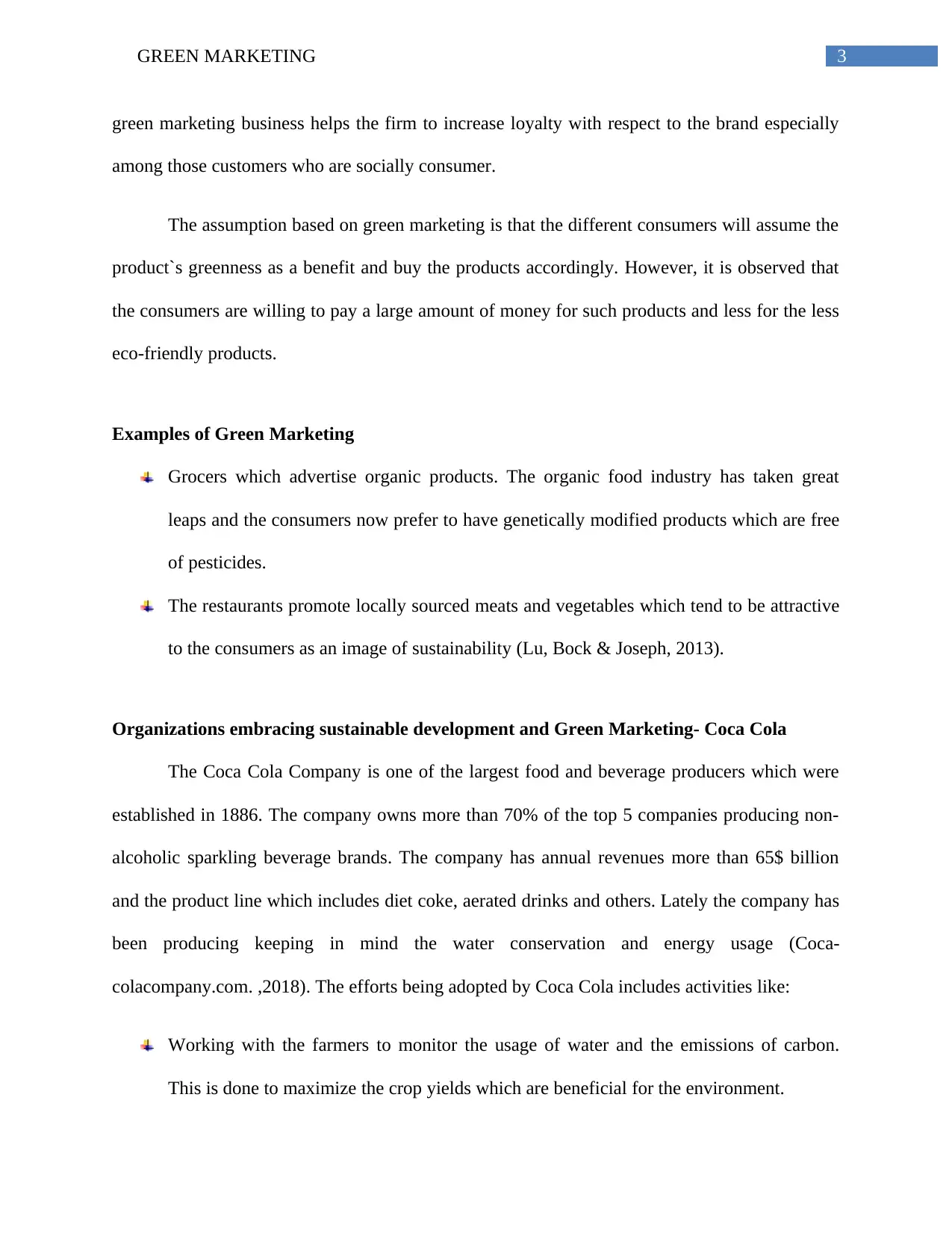
3GREEN MARKETING
green marketing business helps the firm to increase loyalty with respect to the brand especially
among those customers who are socially consumer.
The assumption based on green marketing is that the different consumers will assume the
product`s greenness as a benefit and buy the products accordingly. However, it is observed that
the consumers are willing to pay a large amount of money for such products and less for the less
eco-friendly products.
Examples of Green Marketing
Grocers which advertise organic products. The organic food industry has taken great
leaps and the consumers now prefer to have genetically modified products which are free
of pesticides.
The restaurants promote locally sourced meats and vegetables which tend to be attractive
to the consumers as an image of sustainability (Lu, Bock & Joseph, 2013).
Organizations embracing sustainable development and Green Marketing- Coca Cola
The Coca Cola Company is one of the largest food and beverage producers which were
established in 1886. The company owns more than 70% of the top 5 companies producing non-
alcoholic sparkling beverage brands. The company has annual revenues more than 65$ billion
and the product line which includes diet coke, aerated drinks and others. Lately the company has
been producing keeping in mind the water conservation and energy usage (Coca-
colacompany.com. ,2018). The efforts being adopted by Coca Cola includes activities like:
Working with the farmers to monitor the usage of water and the emissions of carbon.
This is done to maximize the crop yields which are beneficial for the environment.
green marketing business helps the firm to increase loyalty with respect to the brand especially
among those customers who are socially consumer.
The assumption based on green marketing is that the different consumers will assume the
product`s greenness as a benefit and buy the products accordingly. However, it is observed that
the consumers are willing to pay a large amount of money for such products and less for the less
eco-friendly products.
Examples of Green Marketing
Grocers which advertise organic products. The organic food industry has taken great
leaps and the consumers now prefer to have genetically modified products which are free
of pesticides.
The restaurants promote locally sourced meats and vegetables which tend to be attractive
to the consumers as an image of sustainability (Lu, Bock & Joseph, 2013).
Organizations embracing sustainable development and Green Marketing- Coca Cola
The Coca Cola Company is one of the largest food and beverage producers which were
established in 1886. The company owns more than 70% of the top 5 companies producing non-
alcoholic sparkling beverage brands. The company has annual revenues more than 65$ billion
and the product line which includes diet coke, aerated drinks and others. Lately the company has
been producing keeping in mind the water conservation and energy usage (Coca-
colacompany.com. ,2018). The efforts being adopted by Coca Cola includes activities like:
Working with the farmers to monitor the usage of water and the emissions of carbon.
This is done to maximize the crop yields which are beneficial for the environment.
Paraphrase This Document
Need a fresh take? Get an instant paraphrase of this document with our AI Paraphraser
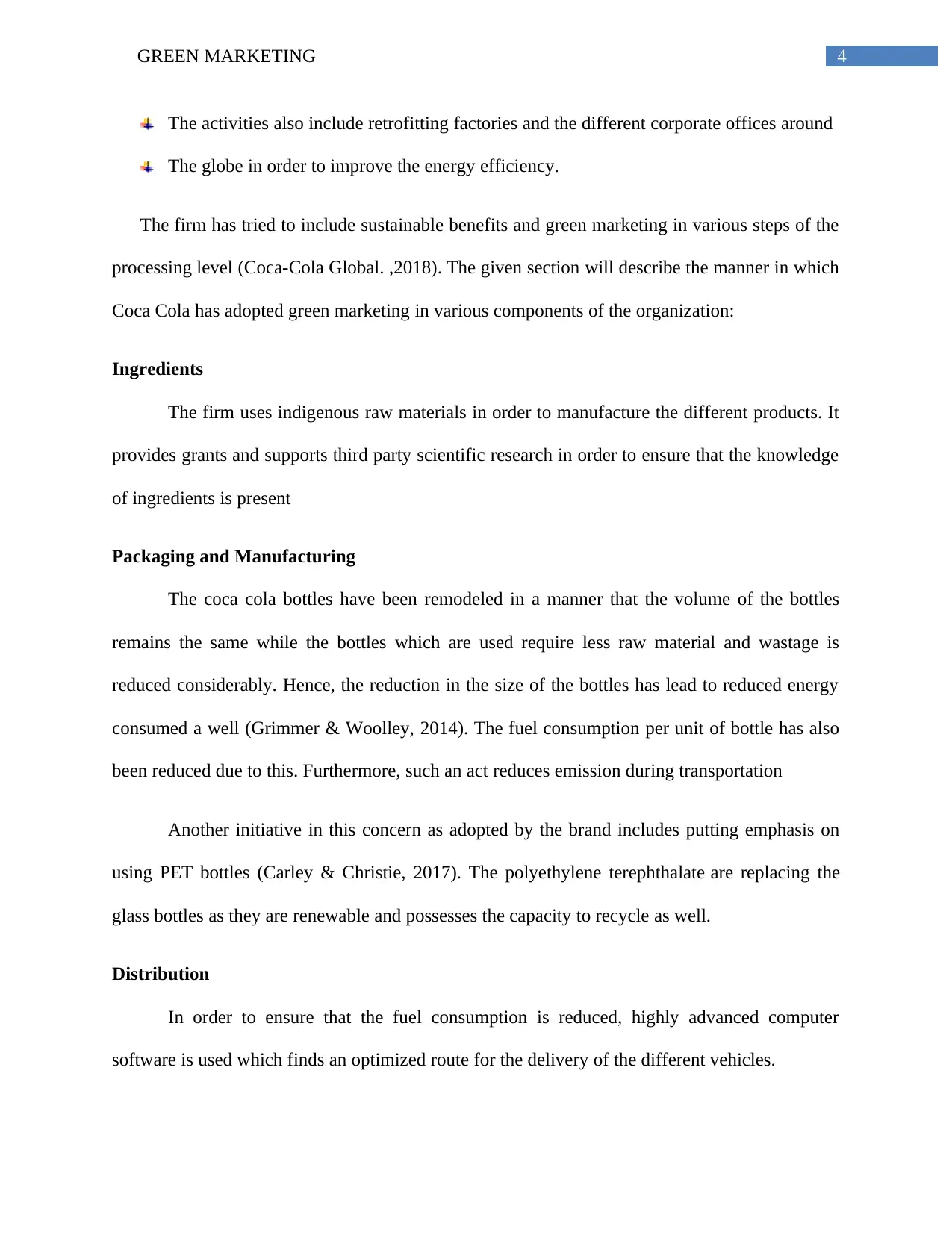
4GREEN MARKETING
The activities also include retrofitting factories and the different corporate offices around
The globe in order to improve the energy efficiency.
The firm has tried to include sustainable benefits and green marketing in various steps of the
processing level (Coca-Cola Global. ,2018). The given section will describe the manner in which
Coca Cola has adopted green marketing in various components of the organization:
Ingredients
The firm uses indigenous raw materials in order to manufacture the different products. It
provides grants and supports third party scientific research in order to ensure that the knowledge
of ingredients is present
Packaging and Manufacturing
The coca cola bottles have been remodeled in a manner that the volume of the bottles
remains the same while the bottles which are used require less raw material and wastage is
reduced considerably. Hence, the reduction in the size of the bottles has lead to reduced energy
consumed a well (Grimmer & Woolley, 2014). The fuel consumption per unit of bottle has also
been reduced due to this. Furthermore, such an act reduces emission during transportation
Another initiative in this concern as adopted by the brand includes putting emphasis on
using PET bottles (Carley & Christie, 2017). The polyethylene terephthalate are replacing the
glass bottles as they are renewable and possesses the capacity to recycle as well.
Distribution
In order to ensure that the fuel consumption is reduced, highly advanced computer
software is used which finds an optimized route for the delivery of the different vehicles.
The activities also include retrofitting factories and the different corporate offices around
The globe in order to improve the energy efficiency.
The firm has tried to include sustainable benefits and green marketing in various steps of the
processing level (Coca-Cola Global. ,2018). The given section will describe the manner in which
Coca Cola has adopted green marketing in various components of the organization:
Ingredients
The firm uses indigenous raw materials in order to manufacture the different products. It
provides grants and supports third party scientific research in order to ensure that the knowledge
of ingredients is present
Packaging and Manufacturing
The coca cola bottles have been remodeled in a manner that the volume of the bottles
remains the same while the bottles which are used require less raw material and wastage is
reduced considerably. Hence, the reduction in the size of the bottles has lead to reduced energy
consumed a well (Grimmer & Woolley, 2014). The fuel consumption per unit of bottle has also
been reduced due to this. Furthermore, such an act reduces emission during transportation
Another initiative in this concern as adopted by the brand includes putting emphasis on
using PET bottles (Carley & Christie, 2017). The polyethylene terephthalate are replacing the
glass bottles as they are renewable and possesses the capacity to recycle as well.
Distribution
In order to ensure that the fuel consumption is reduced, highly advanced computer
software is used which finds an optimized route for the delivery of the different vehicles.
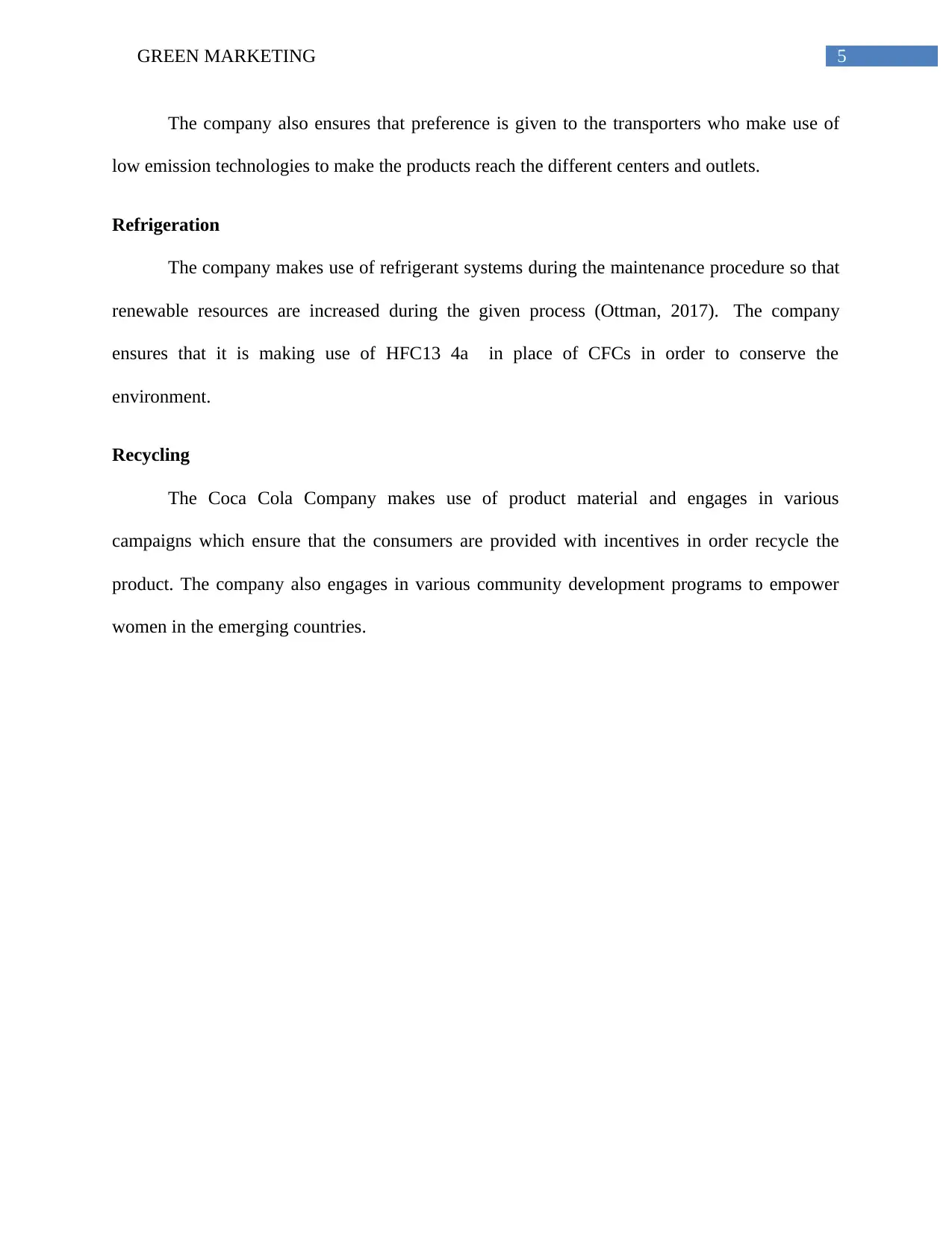
5GREEN MARKETING
The company also ensures that preference is given to the transporters who make use of
low emission technologies to make the products reach the different centers and outlets.
Refrigeration
The company makes use of refrigerant systems during the maintenance procedure so that
renewable resources are increased during the given process (Ottman, 2017). The company
ensures that it is making use of HFC13 4a in place of CFCs in order to conserve the
environment.
Recycling
The Coca Cola Company makes use of product material and engages in various
campaigns which ensure that the consumers are provided with incentives in order recycle the
product. The company also engages in various community development programs to empower
women in the emerging countries.
The company also ensures that preference is given to the transporters who make use of
low emission technologies to make the products reach the different centers and outlets.
Refrigeration
The company makes use of refrigerant systems during the maintenance procedure so that
renewable resources are increased during the given process (Ottman, 2017). The company
ensures that it is making use of HFC13 4a in place of CFCs in order to conserve the
environment.
Recycling
The Coca Cola Company makes use of product material and engages in various
campaigns which ensure that the consumers are provided with incentives in order recycle the
product. The company also engages in various community development programs to empower
women in the emerging countries.
⊘ This is a preview!⊘
Do you want full access?
Subscribe today to unlock all pages.

Trusted by 1+ million students worldwide
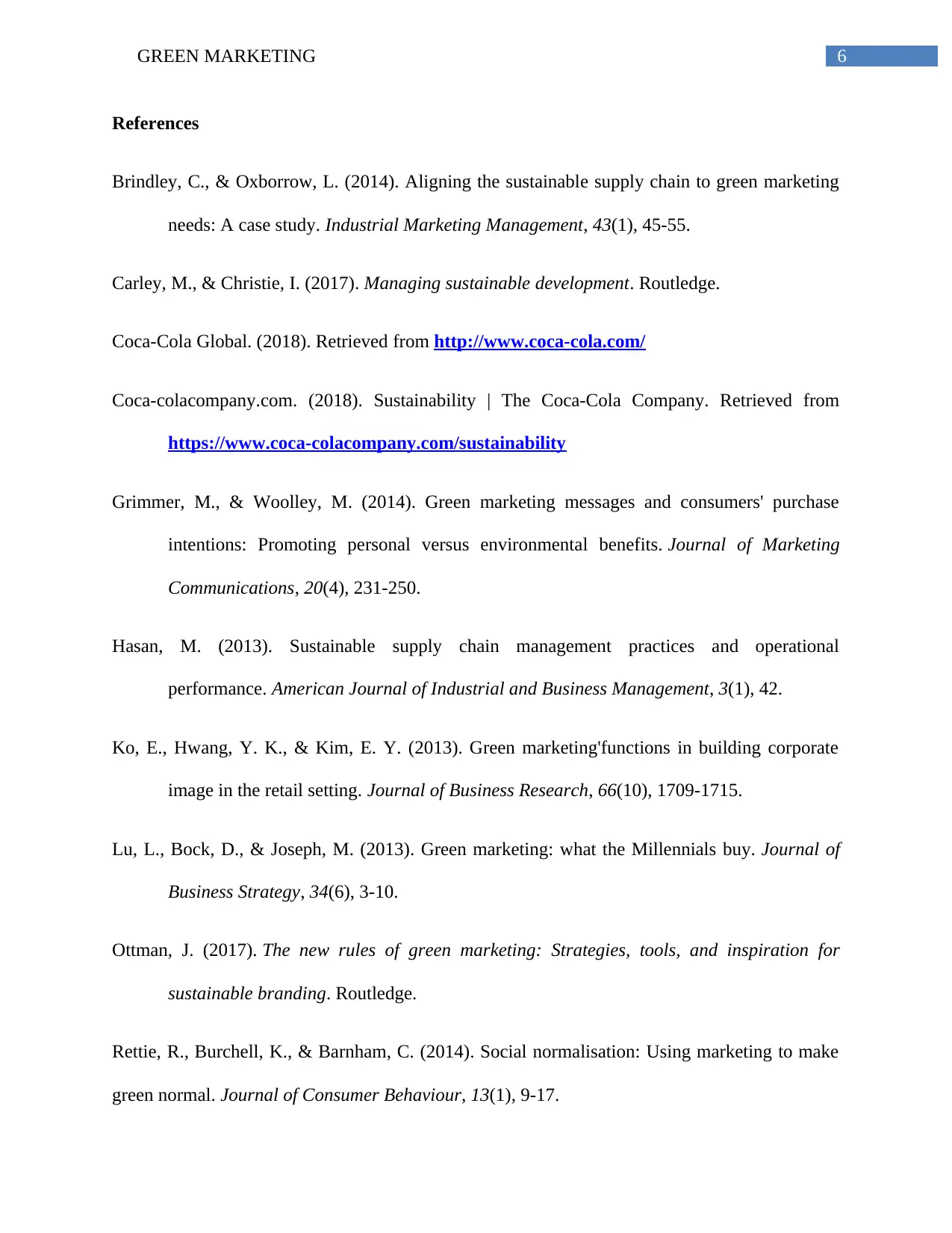
6GREEN MARKETING
References
Brindley, C., & Oxborrow, L. (2014). Aligning the sustainable supply chain to green marketing
needs: A case study. Industrial Marketing Management, 43(1), 45-55.
Carley, M., & Christie, I. (2017). Managing sustainable development. Routledge.
Coca-Cola Global. (2018). Retrieved from http://www.coca-cola.com/
Coca-colacompany.com. (2018). Sustainability | The Coca-Cola Company. Retrieved from
https://www.coca-colacompany.com/sustainability
Grimmer, M., & Woolley, M. (2014). Green marketing messages and consumers' purchase
intentions: Promoting personal versus environmental benefits. Journal of Marketing
Communications, 20(4), 231-250.
Hasan, M. (2013). Sustainable supply chain management practices and operational
performance. American Journal of Industrial and Business Management, 3(1), 42.
Ko, E., Hwang, Y. K., & Kim, E. Y. (2013). Green marketing'functions in building corporate
image in the retail setting. Journal of Business Research, 66(10), 1709-1715.
Lu, L., Bock, D., & Joseph, M. (2013). Green marketing: what the Millennials buy. Journal of
Business Strategy, 34(6), 3-10.
Ottman, J. (2017). The new rules of green marketing: Strategies, tools, and inspiration for
sustainable branding. Routledge.
Rettie, R., Burchell, K., & Barnham, C. (2014). Social normalisation: Using marketing to make
green normal. Journal of Consumer Behaviour, 13(1), 9-17.
References
Brindley, C., & Oxborrow, L. (2014). Aligning the sustainable supply chain to green marketing
needs: A case study. Industrial Marketing Management, 43(1), 45-55.
Carley, M., & Christie, I. (2017). Managing sustainable development. Routledge.
Coca-Cola Global. (2018). Retrieved from http://www.coca-cola.com/
Coca-colacompany.com. (2018). Sustainability | The Coca-Cola Company. Retrieved from
https://www.coca-colacompany.com/sustainability
Grimmer, M., & Woolley, M. (2014). Green marketing messages and consumers' purchase
intentions: Promoting personal versus environmental benefits. Journal of Marketing
Communications, 20(4), 231-250.
Hasan, M. (2013). Sustainable supply chain management practices and operational
performance. American Journal of Industrial and Business Management, 3(1), 42.
Ko, E., Hwang, Y. K., & Kim, E. Y. (2013). Green marketing'functions in building corporate
image in the retail setting. Journal of Business Research, 66(10), 1709-1715.
Lu, L., Bock, D., & Joseph, M. (2013). Green marketing: what the Millennials buy. Journal of
Business Strategy, 34(6), 3-10.
Ottman, J. (2017). The new rules of green marketing: Strategies, tools, and inspiration for
sustainable branding. Routledge.
Rettie, R., Burchell, K., & Barnham, C. (2014). Social normalisation: Using marketing to make
green normal. Journal of Consumer Behaviour, 13(1), 9-17.
1 out of 7
Related Documents
Your All-in-One AI-Powered Toolkit for Academic Success.
+13062052269
info@desklib.com
Available 24*7 on WhatsApp / Email
![[object Object]](/_next/static/media/star-bottom.7253800d.svg)
Unlock your academic potential
Copyright © 2020–2025 A2Z Services. All Rights Reserved. Developed and managed by ZUCOL.



